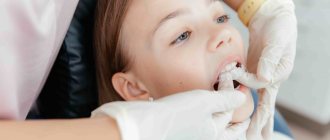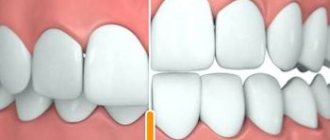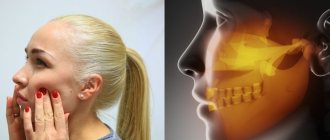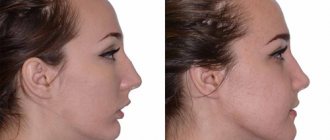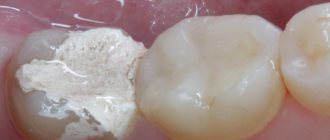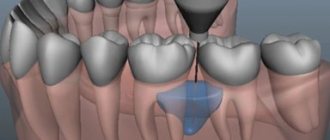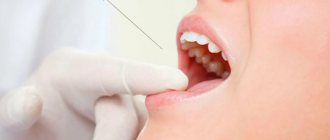When the upper and lower jaws close, the dentition interacts with each other in a special way. This interaction is called "bite". How correctly the dentofacial apparatus functions depends on the nature of the closure of the dentition.
A normal or physiological bite ensures the high-quality functioning of the dental system. A person with a normal bite has clear diction, free breathing, and an attractive smile.
Pathological occlusion is a serious deviation in which the functioning of the masticatory muscles and the temporomandibular joint is impaired. As a result, the patient feels discomfort when chewing food, his teeth deteriorate, his appearance deteriorates, and his quality of life is disrupted.
In order to describe the types of disorders in the structure of the dentofacial apparatus, a classification of occlusions is carried out. There are three degrees in dentistry.
- The first degree assumes a normal or physiological bite. The main signs of a normal bite: there are no pronounced gaps between the closed upper and lower teeth, their contact occurs symmetrically, the central line of the jaws coincides with the midline of the face.
- The second and third degrees indicate the presence of deviations from the norm of varying intensity.
There are different types of normal and pathological occlusion.
Types of normal occlusion
According to statistics, no more than 30% of the population have a normal bite. There are several types of teeth arrangement that meet all the signs of a correct bite:
- Orthognathic. The teeth of the upper jaw overlap the lower teeth by a third of the crown size. When the jaws close, close contact occurs between the teeth.
- Straight. The cutting edges of the upper and lower teeth are in close contact. Correct occlusion of molars and premolars is mandatory.
- Biprognathic. The upper and lower incisors have a slight inclination towards the vestibule of the mouth. There is contact between the incisors, and the upper canines slightly overlap the lower ones.
- Progenic. The teeth of the lower jaw are pushed forward relative to the upper ones. The closure is maintained.
With any type of normal positioning of teeth, bite correction is not carried out, since the load on the teeth is carried out evenly. Food is chewed thoroughly, the temporomandibular joint is not overloaded.
Consequences of malocclusion
All types of malocclusion cause a complex of problems, both dental and more general:
- the development of caries and gingivitis is caused by ineffective oral hygiene. Even with regular and thorough brushing of teeth, due to malocclusion, hard-to-reach areas remain where food debris accumulates and bacteria multiply;
- accelerated tooth decay, abrasion and chipping of enamel - caused by uneven load on the teeth;
- disorders of the gastrointestinal tract that occur due to insufficient chewing of food;
- diseases of the respiratory system due to improper development of the dental system;
- problems with the TMJ, causing pain in the head, ears, back, overstrain of the facial muscles, bruxism, poor posture, etc.;
- violations of facial aesthetics: asymmetry, nasolabial folds, sagging skin of the chin and neck - these and other defects caused by malocclusion can be effectively corrected only with the coordinated work of a cosmetologist and an orthodontist.
Need some advice?
Enter your phone number and we will give you a free consultation
I want a consultation
*By making an appointment you consent to the processing of your data
Types of abnormal bite
Any type of abnormal bite is characterized by the presence of gaps between the teeth of the upper and lower jaw. Lack of contact creates problems when chewing food, diction is impaired, and the oval of the face changes.
- Open is characterized by the presence of areas of non-closure in the anterior or lateral areas of the dentition. It is manifested by the presence of a gap between the teeth of the upper and lower jaw, non-closure of the lips, leading to disruption of the functions of chewing, breathing, and diction.
- Deep . The teeth of the upper dentition overlap the lower ones by more than 30% of the crown height. The most common type of abnormal bite. A strong degree of pathology leads to constant trauma to the mucous membrane of the gums, which is why this type of bite is called traumatic.
- Distal . It is characterized by protrusion of the upper dentition in relation to the lower one due to abnormal development of the upper jaw (or underdevelopment of the lower jaw). External signs are a sloping chin, shortening of the upper lip and retraction of the lower lip. The upper and lower incisors do not have contact, and the lateral ones do not close correctly.
- Cross is characterized by the crossing of the dentition when closing. Characteristic signs are facial asymmetry as a result of uneven development of the jaw areas. The patient complains of diction defects, accidental biting of the inner cheeks and pain when chewing.
- Mesial . It is characterized by the advancement of the lower dentition as a result of underdevelopment of the upper jaw or abnormal development of the lower jaw. Poor contact between the teeth of the lower and upper jaw leads to dysfunction of chewing and speech. Externally, the anomaly is manifested by the presence of a massive chin, a receding upper lip, and a concave face profile.
Dividing each type of abnormal bite into separate subcategories helps determine the degree and nature of the pathology.
If there are even minimal deviations, you should consult an orthodontist for advice. Pathology of the dentofacial apparatus has a tendency to progress and develop complications from the gastrointestinal tract.
Classification
In orthodontic practice, various assessment criteria are used to determine which dental bite is correct and how to correct existing anomalies. The ideal situation, in which nothing needs to be corrected, is characterized by the following indications:
- Semi-elliptical shape of the upper and parabolic shape of the lower arc.
- Small - no more than a third - overlap of the vestibular surface of the mandibular elements.
- Contact of antagonists during closure and absence of obvious gaps.
Compliance on all points is quite rare, but in most cases the deviations are minimal and do not require medical intervention. Often the cause of imbalance is not congenital defects, but bad habits, some of which are formed at an early age.
Types of correct bite
In accordance with the generally accepted classification, there are four main types of occlusal relationships, characterized by the absence of problems and not having a negative effect on the jaw region.
Orthognathic
The optimal, from an aesthetic point of view, is a condition in which all elements of the dentition have an even shape, are located in the correct manner, without gaps or deviations from the midline.
Straight
A common phenomenon, the main feature of which is the lack of overlap - the cutting edges of the incisors meet along a line, which causes a specific type of smile, but is not considered as a pathology.
Biprognathic
Another type of even dentition without threes and diastemas, the distinctive feature of which is a slight deviation of the vertical growth vector of the units. With this development, the crowns are slightly tilted forward.
Progenic
In a normal state it is not accompanied by abnormal manifestations. The identifying feature is a slight frontal protrusion of the lower units.
Causes of pathological bite
The formation of occlusion is a long and complex process that begins at the stage of intrauterine development, continues in early childhood and ends after the end of puberty. Pathological occlusion is the result of long-term influence of a number of unfavorable external or internal factors at different periods of a person’s life:
- Genetic factor. A genetically determined anomaly is formed when there is a congenital discrepancy in the size of the teeth and dentofacial bones (crowding of teeth or the presence of spaces between teeth) or a hereditarily determined abnormal shape and size of the lower and upper jaws.
- The influence of negative factors on the body of a pregnant woman. The formation of the dental apparatus in the fetus can be influenced by bad habits, poor nutrition and diseases suffered by a woman during pregnancy.
- Birth injury. During childbirth, the baby may receive injuries leading to displacement of the temporomandibular joint.
- Negative factors affecting the baby’s body in the first years of life. The reason for the formation of a distal bite may be the incorrect selection of nipples or the late introduction of solid foods into the diet.
- Bad habits and behavioral factors in early childhood. The habit of sucking a pacifier or finger, or sleeping with the head thrown back can cause a child to develop a deep bite.
- Factors influencing the formation of anomalies in later life. These include carious lesions of the teeth, ENT pathologies, deviated nasal septum, and diseases of the skeletal system.
Treatment of abnormal bite should begin as early as possible. Early diagnosis and therapy make it possible to restore the normal functioning of the dentofacial apparatus more effectively. Doctors at the Consilium-Dent use specially developed diagnostic tests and tables. They are used both for direct examination of the oral cavity and for diagnosis using dental casts.
The need for a particular therapeutic measure is determined by a specialist based on the diagnostic results on an individual basis. You cannot resort to self-medication in this situation. This can lead to activation of the pathological process.
How to form?
photo: diagram of the correct bite in a person
What do orthodontists advise to form the correct position of teeth:
- Breastfeeding is very important for a child; it lays the foundation for the correct development of the jaws.
If you had to feed your child with formula, it is best to purchase a pacifier that does not spoil the bite. The sucking hole should be made narrow so that the baby has to suck with effort. The lower jaw in infants is underdeveloped and muscle exercises (forceful sucking) are important for its proper functioning in the future. - Formation of correct chewing habits. You should not accustom your baby to a pacifier. From the moment of teething, the baby should be offered complementary foods for the habit of proper chewing.
- Parents should pay attention to how their child breathes. Physiological breathing through the nose. Breathing through the mouth is a sign of ENT diseases. They must be treated: in addition to general damage to health, this is a dangerous factor in the formation of a defective bite.
- From the moment of complete eruption of baby teeth, regular examinations by an orthodontist (every six months). When abnormalities are diagnosed at an early age, they are much easier to treat.
Common types of malocclusions
The most common anomalies of the dental system include deep bite. A severe degree of pathology is characterized by a situation where the upper row of teeth completely overlaps the lower row. When the jaws are closed, the upper incisors can injure the mucous membrane of the lower gums. Therefore, this type of anomaly is called a traumatic bite.
A deep bite is accompanied by a violation of facial aesthetics, impaired diction, poor quality of chewing food, and increased abrasion of the enamel.
There are two degrees of development of pathology. They are caused by various provoking factors and are characterized by different forms of manifestation:
- Primary deep bite is often due to genetic reasons and is determined by the special structure of the facial bones. It manifests itself as pathological changes in the area of the dentition, alveolar process and basal part of the jaws. The movement of the jaws is blocked, and the patient experiences significant discomfort when chewing.
- Secondary deep bite is acquired in nature and is a consequence of a disease or injury. As a result of a decrease in the interalveolar distance and the lower third of the face, a deep traumatic closure of the incisors develops.
Another type of pathology classification is carried out depending on the nature of the interaction of the lateral teeth.
- A deep distal bite is characterized by the overlap of the lower row of teeth with the upper ones by more than one third of the length of the crown with a violation of the relationship of the lateral teeth. Characteristic disorders include difficulty biting and chewing, breathing problems, and pain in the temporomandibular joint.
- Deep neutral bite: when the overlap of the lower front teeth with the upper ones is disturbed, while the position of the lateral teeth is not disturbed.
If you experience even minor discomfort when chewing, you should immediately contact a specialist and follow his recommendations.
The presence of a malocclusion or a predisposition to it is determined by an orthodontist after an initial examination using special tests. Self-diagnosis does not provide an objective picture of the condition of the dentofacial apparatus, since different pathologies may have the same symptoms. Treatment in this case will be radically different.
If there are no problems with your bite, you should visit the orthodontist for a preventive examination approximately once every six months. The doctor will determine whether there is a tendency to a particular anomaly even before the problem is noticeable.
Causes of occlusion violation
A person’s dental bite is formed by the age of 16-17 years. The main cause of occlusal anomalies is disturbances in the development of the jaws. In this case, wide interdental spaces may form between the central incisors (diastema) or other teeth (trema), or, on the contrary, crowding of teeth may occur. Due to lack of space, individual teeth may be located outside the dental arch (dystopia), rotated around an axis (rotation), or overlap each other. A lack of space between adjacent teeth of 2-3 mm is considered a mild degree of crowding, 7 mm or more is diagnosed as a severe degree of pathology.
Malocclusion can also be caused by:
- long-term use of a pacifier;
- the child's habit of thumb sucking;
- chronic ENT diseases, due to which the child breathes through the mouth most of the time;
- late teething;
- edentia (congenital absence of one or more teeth).
- diseases of the central nervous system (epilepsy, cerebral palsy);
- prolonged inflammatory processes in the area of the jaw joints.
Violations of occlusion often lead to inflammation of the gums, rapid abrasion of tooth enamel and the development of carious processes. If there is poor contact between the teeth, food is not chewed enough, which provokes the development of gastrointestinal diseases. Therefore, correcting malocclusion is important not so much for aesthetic reasons as for maintaining health.
The influence of malocclusion on appearance
The importance of routine observations in normal occlusion
In children with an orthognathic or straight bite, the arrangement of dental units in a row may change due to untimely (early or late) change of primary teeth. During a preventive examination, the orthodontist will identify the presence of abnormalities in the rudiment itself. The following types of preventive measures are carried out:
- Clinical examination (allows us to identify existing anomalies and risk factors).
- Formation of groups of patients for further clinical observation.
- Drawing up a plan of preventive and therapeutic measures (pediatricians of all profiles participate).
In adult patients with normal dentition, malocclusion can develop under the influence of external and internal unfavorable factors. The main reasons that increase the risk of developing dental anomalies in adults are:
- carious process;
- loss of teeth;
- various types of prosthetics;
- prosthetics errors;
- bad habits.
During the examination, the dentist will identify the presence of predisposing factors, after which he will develop a scheme for carrying out preventive measures to maintain a normal bite. Selection is carried out on an individual basis, taking into account the condition of the dental system and the physiological characteristics of the patient’s body.
Stages of formation
In order to understand what pathological bites are, you need to understand what factors provoke their appearance. Formation occurs from the moment of birth and lasts until adolescence (approximately 16 years).
It all starts with the appearance of the first incisors. The bite is determined after the replacement of milk teeth with molars. It is influenced by external factors and heredity. The most common reason is prolonged sucking of the nipple or objects that replace it. It is best to breastfeed the baby and wean it after one year.
The baby's sleep should be calm, breathing should be through the nasal cavity, and the mouth should be closed. Problems can arise due to cleft lip and palate (in the common sense, such a defect is called a “cleft palate”), adenoids, and so on. All this must be treated immediately and the situation must not be allowed to worsen. Sometimes the eruption of molars is delayed, and this causes the row to shift. As a result, an incorrect bite is formed.
Orthodontics is a branch of dentistry that deals with the comprehensive study of dental anomalies. It is this doctor who is able to determine the type of bite and prescribe corrective measures.
Treatment of malocclusions
Before prescribing treatment procedures, the orthodontist assesses the condition of the oral cavity, carefully examines the depth of the problem and the presence of concomitant pathologies, taking into account the patient’s age. Treatment of dental anomalies is carried out using conservative and radical methods:
- Braces are the most popular method of bite correction. This orthodontic method has the widest range of applications and is suitable for solving any problem of malocclusion. Treatment with this method is long and includes preparatory, main and retention (recovery) periods.
- Aligners. Removable structures are used to treat the initial stages of deviation. With their help, a gentle correction of the dentoalveolar apparatus is carried out, changing one set of mouthguards to another.
- Application of veneers, onlays, crowns. Weak areas of the dentition that are susceptible to caries are protected by using orthopedic structures. Chipped areas of enamel are restored using ceramic onlays and veneers.
- Surgical intervention is performed to treat late stages of dental anomalies (mainly of a hereditary nature). During the operation, the position of the jaws is changed, their size is reduced or increased.
Laser therapy is performed as an auxiliary treatment to help speed up regeneration and reduce the risk of complications.
Correction methods
Modern orthodontics offers a wide arsenal of instruments, accessories and treatment techniques that can eliminate occlusion disorders.
- Orthodontic plate. A removable device for straightening teeth, consisting of a plastic base that fits tightly to the palate or gum, and metal clamps that gradually shift the tooth into the desired position.
- Braces. Fixed structures that are considered effective for correcting almost all types of malocclusion. Braces can be made of metal, ceramic or plastic.
- Trainers. These are removable dental splints made of silicone or polyurethane. Correcting the position of teeth with trainers includes three stages: preparatory, main and consolidating, each stage takes about six months.
- Aligners. Transparent removable orthodontic structures made of hypoallergenic plastics, in many cases capable of replacing fashionable braces. Aligners are made individually, based on impressions of the patient’s teeth or the results of a digital scan of the jaw.
Orthodontic devices for bite correction
In exceptional cases, in the presence of serious occlusion disorders that have developed due to congenital pathologies of the structure of the skull bones or after jaw deformation as a result of trauma, when it is clear that non-invasive methods for correcting occlusion anomalies will not be effective, surgical intervention is indicated.
Types of prevention of malocclusions
Prevention of malocclusion in childhood is very important, as it determines whether the child will have problems in the future. Adults should monitor the eruption of permanent teeth in children and visit an orthodontist with the child for timely detection of anomalies and bite correction.
Prevention of malocclusions involves eliminating bad habits that cause one or another anomaly: lip biting, finger sucking in children. To do this, special plates are used that block the ability to use a bad habit. In adults, such methods help cure abnormalities in the early stages.
It is important to carry out sanitation of the oral cavity in a timely manner and periodically come for medical examinations to the dentist. Children from the age of six months should be taught to chew solid food.
A good method of prevention is specially designed therapeutic exercises. When performing exercises, the patient puts the correct load on the jaw muscles, which contributes to the harmonious development of the maxillofacial system.
Treatment for missing teeth
The specificity of the anatomical structure of the jaw apparatus is that even complete edentia does not guarantee the formation of correct occlusion after implantation. The result of prosthetics is largely determined by the degree of development of defects and anomalies that formed even before the loss or removal of elements. If the row ratio was within acceptable limits, it is enough for the doctor to take into account the necessary adjustments when developing a replacement structure, but the presence of problems with bone tissue will require the use of more complex restoration techniques.
How to check and find out if the bite is correct when making a jaw prosthesis without teeth? For this purpose, special wax rollers are used, placed in the oral cavity. The measuring instruments are a ruler arc and an intraoral plate. After collecting the necessary readings, first a plaster prototype is created, and then the final structure.
Bite formation in children
At the stage of bite formation in children, there are three most important periods:
- The milk bite begins to form at six months of age and continues until 3 years of age. This is the initial stage during which the foundation for the formation of a permanent bite is laid.
- The change to a permanent dentition lasts up to 9 years. During this period, the jaws actively develop and a permanent bite begins to form. During this period, when the dentition consists of baby and permanent teeth, children often develop malocclusions. Common causes are a violation of the pairing of teeth erupting with an unequal degree of development of the jaw sections.
- The formation of a permanent bite occurs from 12 to 15 years. The replacement of baby teeth ends, permanent teeth complete their growth and are installed in their permanent places.
Prevention of malocclusion in childhood is very important, as it determines whether the child will have problems in the future. Adults should monitor the eruption of permanent teeth in children and visit an orthodontist with the child for timely detection of anomalies and bite correction.
Signs and causes of defects in the position of teeth in humans
In addition to aesthetic shortcomings, malocclusion affects dental health.
A number of signs indicate disturbances in the structure of the dental lines :
- the presence of a cosmetic defect in the form of an underdeveloped jaw;
- unnatural jaw position;
- the presence of wide gaps in the dental line, incorrectly located teeth;
- speech disorders;
- difficulty chewing food.
All malocclusions have their own classification depending on the section of the dental line in which the anomaly is observed.
Dental defects in children and adults can occur for the following reasons :
- trauma during childbirth;
- genetic predisposition;
- artificial feeding;
- the habit of thumb or pacifier sucking in young children;
- incorrect change of teeth;
- breathing problems;
- complications after prosthetics;
- hormonal imbalance, metabolic disorders;
- unbalanced diet;
- lack of fluorine, calcium and other elements necessary for the normal formation of the dentofacial apparatus;
- caries;
- injuries and diseases of the dental system;
- pathologies of wisdom teeth growth;
- untimely replacement of lost or extracted teeth.
Types and characteristics of pathologies
Sagittal
Sagittal pathologies of the dentofacial apparatus include disturbances of occlusion that occur in the anteroposterior direction, that is, one of the jaws is pushed forward and noticeably predominates over the other.
The group of sagittal defects includes two types of bites: distal and mesial. Treatment can be carried out using different orthodontic structures, as well as surgical and combined methods. The selection of therapeutic agents is based on the clinical picture. In this case, therapy is aimed at normalizing the area of occlusion and stimulating or suppressing the growth of one of the displaced jaws.
Vertical
A characteristic sign of vertical pathology: too high or low position of a group of teeth relative to occlusion, while the features of the manifestation of pathology depend on its severity and localization.
Such anomalies include open and deep bite types. With a vertical anomaly, the loss of one of the teeth often leads to dentoalveolar elongation - excessive growth of the antagonist tooth until it comes into contact with the oral mucosa.
In children, treatment of vertical anomalies usually comes down to eliminating the causes of the pathology. For this, adults have to resort to the use of non-removable orthodontic structures.
Transversal
Transversal defects include the crossbite type. This type of pathology is characterized by one of the following symptoms :
- Lateral displacement of one of the dentitions;
- The presence of disproportions: one of the dentitions may be significantly wider or narrower than the other;
- Pathological narrowing of the jaw.
Pathologies of this type are corrected with the help of expanding structures, having previously isolated the dental lines. Severe, pronounced defects require surgical intervention.
Attention: it is important to begin correcting transverse anomalies as early as possible when the first symptoms appear.
What different types of malocclusion look like:

